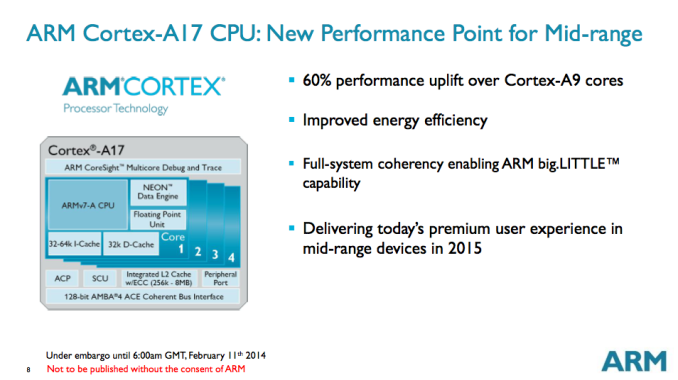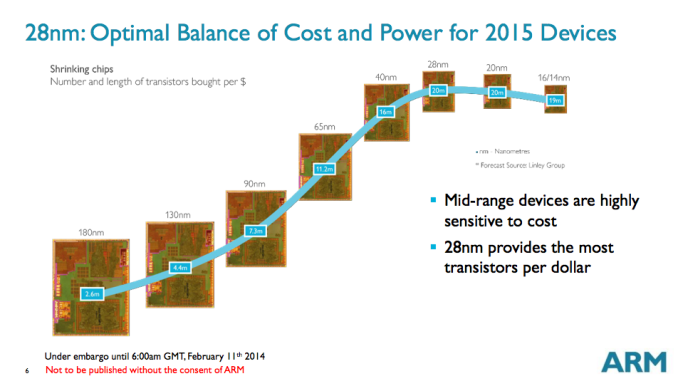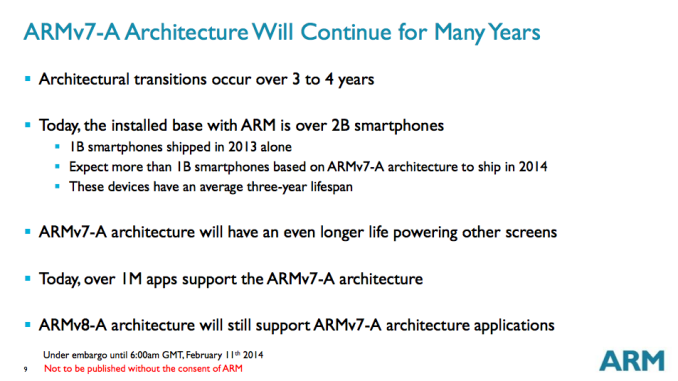ARM Cortex A17: An Evolved Cortex A12 for the Mainstream in 2015
by Anand Lal Shimpi on February 11, 2014 1:00 AM EST- Posted in
- SoCs
- Arm
- Smartphones
- Mobile
- Tablets
- Cortex A17

ARM has been doing a good job figuring out its PR strategy as of late. In the span of a couple of years we went from very little outward communication to semi-deep-dives on architecture and a regular cadence of IP disclosures. ARM continues its new trend today with the announcement of its 2015 mid-range CPU IP: the Cortex A17.
As its name implies, the Cortex A17 is a 32-bit ARMv7-A CPU design (64-bit ARMv8 cores belong to the Cortex A50 series - e.g. A53/A57). The best way to think about Cortex A17 is as an evolution of the recently announced Cortex A12, rather than anything to do with the Cortex A15. ARM's Cortex A17 takes the basic 2-wide out-of-order architecture of the Cortex A12 and improves it. Specific details are still light at this point, but I'm told that the front end and execution engine are similar to Cortex A12, with most of the performance/efficiency gains coming from improvements to the memory subsystem.
The result is a design that is roughly 60% faster than a Cortex A9r4 at a given frequency/process/memory interface (Cortex A12 is 40% faster than A9r4 under the same conditions). Using ARM's own DMIPS/MHz ratings I threw together a little table of relative/estimated performance ratings to help put all of this in perspective:
| ARM 2014/2015 CPU IP lineup | |||||||||
| CPU IP | Target | Estimated DMIPS/MHz | big.LITTLE | Shipping in Devices/Systems | |||||
| Cortex A57 | High-end mobile/servers | 5* | Yes (w/ A53) | 2015 | |||||
| Cortex A53 | Low-end mobile | 2.3 | Yes, LITTLE, w/ A57 | 2H 2014 | |||||
| Cortex A17 | Mid-range mobile | 4.0* | Yes, big, w/ A7 | Early 2015 | |||||
| Cortex A15 | High-end mobile | 4.0* | Yes, big, w/ A7 | Now | |||||
| Cortex A12 | Mid-range mobile | 3.5 | No | 2H 2014 | |||||
| Cortex A9 | High-end mobile | 2.5 | No | Now | |||||
| Cortex A7 | Low-end mobile | 1.9 | Yes, LITTLE, w/ A15/A17 | Now | |||||
*Estimate based on ARM's claims
On a given process node, the Cortex A17 can occupy around 20% more area than a Cortex A9 or a marginal increase over a Cortex A12 design. Running the same workload, ARM expects the Cortex A17 to be 20% more energy efficient than the Cortex A9 (race to sleep), but I'd expect higher peak power consumption from the A17. The Cortex A17 name was deliberately chosen as ARM expects to be able to deliver similar performance to the Cortex A15 (in mobile apps/benchmarks, likely not in absolute performance), but in a much smaller area and at a lower power. I can't help but wonder if this is what the Cortex A15 should have been from the very beginning, at least for mobile applications.
ARM expects many early Cortex A17 designs to be built on a 28nm process, with an eventual shift over to 20nm once the cost of that process drops. ARM supplied an interesting slide showcasing the number of transistors $1 will buy you as a function of process node:
If you're a fabless semiconductor, it looks like 28nm will be the sweet spot for manufacturing for a little while.
Keep in mind that the target market for the Cortex A17, like the Cortex A12, is somewhere in between a device like the Moto G and the latest flagship Galaxy S device from Samsung.
big.LITTLE Support
If you remember back to our analysis of the Cortex A12, the first version of the core didn't support ARM's big.LITTLE (lacking the requisite coherent interface) but a future version was promised with big.LITTLE support. The Cortex A17 is that future version. In a big.LITTLE configuration, the Cortex A17 will function as the "big" core(s) while the Cortex A7 will serve as the "LITTLE" core(s).
Rather than giving the Cortex A12 a new major revision number, ARM improved the design, added big.LITTLE support and called the finished product the Cortex A17. It's an interesting approach to dealing with the fact that ARM can rev/improve a single IP offering many times over the course of its life. In case it isn't already obvious, there won't be a big.LITTLE version of the Cortex A12.
ARM expects some overlap between Cortex A17 and Cortex A12. If a customer is looking to ship in 2014, Cortex A12 will be the only option for them in the mid-range from ARM. If a customer wants big.LITTLE or they are starting a design now, Cortex A17 is the obvious fit. I expect Cortex A17 will contribute to a relatively short lifespan for Cortex A12 in the grand scheme of things.
ARM sees some of the biggest opportunities in addressing the entry level and performance mainstream smartphone markets going forward. With the Cortex A17 aiming at the latter, ARM sees a potential market of around 450 million devices in 2015. The lack of 64-bit support makes ARM's mid-range lineup a little odd, especially considering the Cortex A53 and Cortex A57 will ensure both entry level and high-end smartphones will be 64-bit enabled. While I don't have an issue with a good mid-range device shipping without 64-bit support, I'm not sure how handset and tablet OEMs will feel. With Apple, Intel (and likely Qualcomm), embracing 64-bit-only strategies in mobile, I do wonder just how much success these A12/A17 architectures will have over the long run.
ARM tells me we should see the first devices using Cortex A17 CPU cores shipping in early 2015. Cortex A17 IP will be available to ARM customers for implementation by the end of this quarter.














41 Comments
View All Comments
Wilco1 - Tuesday, February 11, 2014 - link
An A55 variant of A17 wouldn't make much sense as it is not that much slower than A57 (based on Anand's comparison above and published frequency of A12 of 2.3GHz).You need to remember is there is no 64-bit mainstream yet for ARM (A53 as a standalone core will serve low-end as it is basically a faster A7). Whether ARM will add a mid-range 64-bit core depends a bit on the gap between any the future 64-bit big core and its little variant. If that gap narrows then there may not be any use for it.
HisDivineOrder - Wednesday, February 12, 2014 - link
They want to continue to push out chips where 64-bit support is a premium advantage over the lower cost CPU's.They're going to up-sell based on that very desired feature. Watch. In no time, they'll have a 64-bit compatible version of the A17 and it'll cost a premium. Then you'll have your answer.
It's the same reason Intel insists on selling a single CPU that doesn't have their best (non-Iris) integrated GPU despite it taking up the same space no matter what. It's because Intel wants to charge you a premium for that feature a lot of people might want.
ARM's just learned their lessons from the big boys.
DanNeely - Thursday, February 13, 2014 - link
That's not true. Intel is using different dies for the GT3 (non-iris) and GT2 variants of Haswell. GT1 chips (Pentium/Celeron) might use the same die as dual core GT2 parts instead of a GT1 version (haven't seen anything about this either way). However historically the Celeron has been a dumping ground for dies with bad regions that can't be sold as higher end models, and I've no reason to believe they've magically improved yields to the point they don't need to bin semi-faulty dies to avoid throwing them out.http://anandtech.com/show/7744/intel-reveals-new-h...
Krysto - Tuesday, February 11, 2014 - link
Very disappointing move from ARM, I have to say. They missed yet another chance to move completely to 64-bit ARMv8 from low-end to high-end.They say "platforms take 3-4 years to transitions", in this case it's because THEY are making it so. They're not prolonging the life of ARMv7 by at least 2 more years, when we could've moved to ARMv8 completely 2 years faster. That's a lot of time. I don't care what's their excuse for this move. Don't tell me it's to lower price and system requirements, because then they wouldn't have made A53 on ARMv8. It's a big strategic f-up on their part. I'd rather buy a phone with a quad-core A53 than A12 or A17 going forward.
Maintaining the 28nm process for these chips for another year (2 would be a mistake) is reasonable. Maintaining everyone on 32-bit for 2 more years definitely isn't. This was a strategic call, and they made a bad one.
Wilco1 - Tuesday, February 11, 2014 - link
You have to remember ARM only makes cores that it can sell - A17 wouldn't exist if there wasn't at least one lead partner keen to buy it. Clearly the Mediatek's of this world are more interested in an efficient and cheap 32-bit core than a 64-bit core that most likely never will run any 64-bit code (just like my old Athlon64 never ran any x64 code it its entire life - where is 64-bit Android?), and thus paying an area, cost and possibly power penalty for no benefit.I think ARMv7 will pretty much exist forever (like ARM7tdmi!) as I don't think everybody will jump on the 64-bit bandwagon. Especially the low and mid-end won't need it, and even in the high-end I really don't see an advantage today (as ARMv7 has PAE). I certainly expect ARMv7 to be quite popular 5 years from now, even if most mobiles have switched to 64-bit by then.
DanNeely - Tuesday, February 11, 2014 - link
Even when the mid range phone/tablet arm core is 64bit, they'll still have a large number of cores designed for far lower power budgets that will likely remain 32bit for a number of years because there's precisely zero benefit to 64bit in the systems they're being used for.Wilco1 - Tuesday, February 11, 2014 - link
Correct, and that includes lots of markets outside of mobiles. Small routers, printers, GPS or car infotainment do not need 64-bit.Morawka - Tuesday, February 11, 2014 - link
i dont understand why the A57 isnt shipping till 2015, that's crazy. Its slower than Apple's A7 yet is taking longer and longer to fab.darkich - Tuesday, February 11, 2014 - link
Not to mention the Denver cores from Nvidia.Those seem to be far more advanced and powerful even than the Cyclone CPU(even if only for the clock speed advantage)..and they are coming in Q3/Q4
Wilco1 - Tuesday, February 11, 2014 - link
That's a mistake, that should be 2014. And A57 is much faster than Apple's A7 as it runs at a much higher frequency.